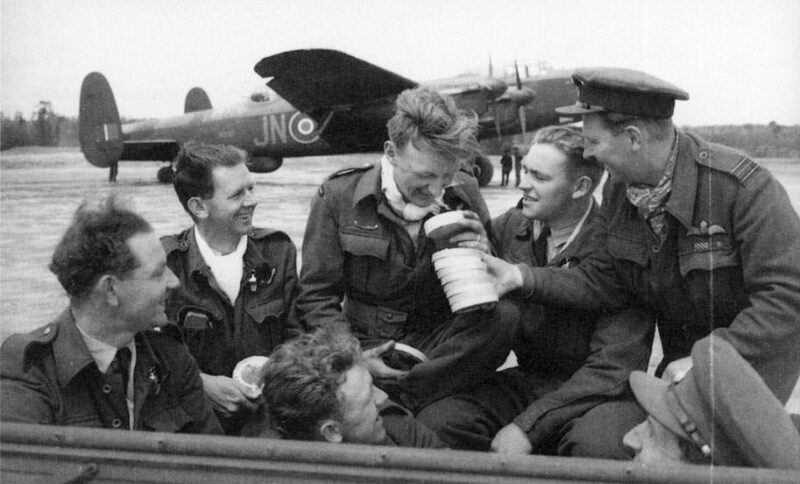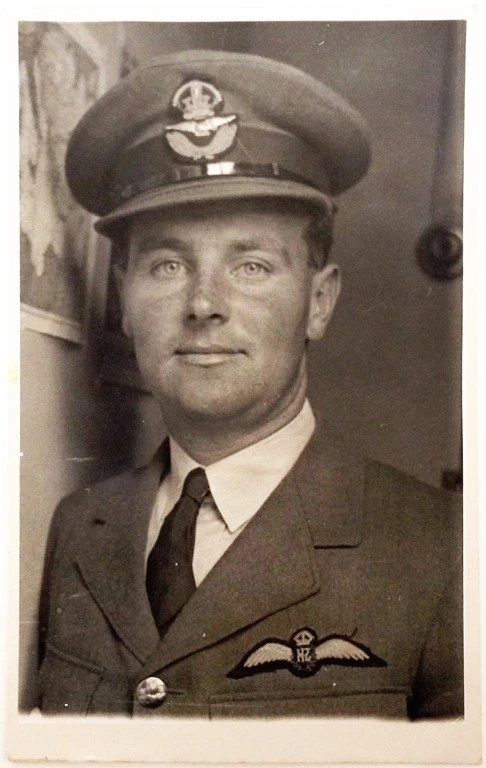Stories
Stories
The first heavy bomber to land in liberated France
Not long after D-Day, on the 21 st of June 1944, Squadron Leader Nick Williamson RNZAF was posted in to 75 (NZ) Squadron as the new Commander of “C” Flight. Williamson, from Gisborne, had completed a full tour of operations and earned the DFC at 214 Squadron flying Stirlings. On arrival he inherited a “headless” crew whose skipper Flying Officer Frank Lukey had just been lost on his “second-dickey” trip, his very first operation to gain experience with a veteran crew.

Williamson crew
(Credit Unknown)
Caption: Lancaster ND917 of No 75 Squadron on one of the Advanced Landing Grounds on the Normandy beachhead on 31 June 1944. The photograph, taken next day, shows Williamson presenting bomb-aimer Fg Off G. Couth with Camembert cheese produced in the district to mark his 23rd birthday. Other members of the crew are Fg Off J. Watts, navigator; Sgt J. Russell, rear gunner; Sgt R. Jones, mid-upper gunner; and Sgt S.Cooke, wireless operator. (Credit 75(NZ) Squadron website)
On the 30th of June, Williamson and his new crew found themselves on the Battle Order, a daylight operation to a road junction at Villers-Bocage in the north of France involving precision bombing of German tanks and troops in support of the British and Canadian Armies.
The crew was:
S/L N.A. ‘Nick’ Williamson, RNZAF NZ411438 – Pilot.
F/O John Watts, RNZAF NZ427239 – Navigator.
F/O Graham Coull, RNZAF NZ425883 – Air Bomber.
Sgt. Stan Cooke, RAFVR – Wireless Operator .
Sgt. Patrick McDevitt, RAFVR 1586862 – Flight Engineer.
Sgt. R. Jones, RAFVR – Mid Upper Gunner.
Sgt. J. Russell, RAFVR – Rear Gunner.
They took off from Mepal at 1813 hrs in Lancaster ND917, JN-O, one of twenty-two aircraft put up by the squadron.Just as they were about to make their bombing run, the aircraft was hit by flak and a splinter tore away the Flight Engineer’s knee cap.
Sgt Patrick McDevitt did not protest and the crew proceeded to make their attack and turn for home. Then Williamson realised McDevitt was in serious distress and losing so much blood that he might not make it back to England. In search of immediate medical attention Williamson decided he would risk a landing in Allied-held territory.
On the way to the target he had noticed a fighter strip (thought to be Advanced Landing Ground – ALG B7) near the Normandy beach head so he left the bomber stream and dived towards the small freshly-bulldozed strip.
As if landing a Lancaster on a fighter strip wasn’t difficult enough, to avoid the circuit, which would have taken him over enemy lines, he had to land downwind, running off the end into a wheat field. He brought the aircraft to a stop with a gentle ground loop. The dirt strip had only been completed a week before and was about half the length of the concrete runways that Lancasters normally operated from.
One can only imagine the startled looks around the airfield. It was the first Allied heavy bomber to land in liberated Europe, and incredibly, Williamson’s first ever operation in a Lancaster. In fact, once McDevitt had been rushed off to a field hospital by ambulance, Williamson was unable to take off again, having to wait for the Flight Engineer to recover sufficiently to give him the correct starting procedure!
The crew treated their unplanned stopover in France as a great adventure, making a day-trip to Bayeux, which was largely untouched by the fighting, and visiting McDevitt in hospital. Although feeling much better after a blood transfusion, he was still too sick to fly back with them. The crew were also keen to experience the war on the ground, visiting the front line, arming themselves and joining in the shooting for a time!
“On our way back we stopped at an estaminet (tavern) but the French madame coolly told us she hadn’t any wine left. An army officer whispered the words ‘aviateur anglais’, and to my embarrassment the lady threw her arms around me, kissed me, and repeatedly cried ‘Bon, bon!’. And most important of all, produced bottles of wine.”
After three days, with the technical issues sorted and the weather clearing, the boys loaded the aircraft with souvenirs for the trip back to England, including French cheeses, wine, cognac, a swastika flag, a German Mauser rifle, and a machine gun!

S/L Nick Williamson
(Credit 75(NZ) Squadron website)
“Bomb Aimer, Flight Sergeant Graham Coull had his 22nd birthday while we were there and of course we celebrated correctly, and each member of the crew presented him with a highly smelling “Camembert” cheese as a birthday gift. An Army reporter took an excellent photo of the presenting of the cheeses in a Jeep.” Coull also filled in as Flight Engineer for the flight back to England.
“For the take off, an extra high run was made into a wheat field, and not realising the danger from swing, Army vehicles of all shapes and sizes had lined the strip two and three deep each side, and even at the far end, to wave us an enthusiastic farewell. The four Merlins, however, and good luck, took us off without mishap and not having our Engineer I hoped I had turned all the petrol cocks on correctly. Our escort of Spitfires and Mustangs led us 100 feet over Mulberry Harbour and to many waves from tanks and ships, we made for home.”
“Visibility was bad and we first had to make a landing near Manston, but later managed to get permission to make for our home drome, where we received a great welcome from the Station Commander G/Capt. Campbell, W/C Leslie D.S.O., A.F.C. and almost the whole station, as we had been reported as missing, seeing that we had been unable to contact Command until the end of the second day, and two crews had reported seeing my aircraft diving towards the ground over the target area.
Even the Committee of Adjustment had packed away our personal belongings, but once these were released from bondage, the red wine we had located flowed freely and all was well.”
“The greatest welcome I received was from my 6 months old black Labrador pup “Rex” who had refused to eat during my absence. Two and a half hours before the aircraft landed at Mepal he had become wildly excited and was waiting out at “C” Flight Dispersal area, refusing to leave where my aircraft was usually parked.”